Railroad Time
Railroad Pocket Watches and the CPR
February 9, 2000

When one thinks of the glory days of railroading, there are two images that inevitably come to mind, those of the steam locomotive, and the conductor with his gold pocket watch. I can remember, as a young boy, being taken by my grandfather to see the train coming in at Windsor Station in Montreal. I can still remember standing next to those giant driving wheels, amidst the swirl of steam and the smell of coal smoke, as my grandfather introduced me to those gods of steam, then engineer and the conductor.
What a thrill to be lifted up into the inner sanctum of the cab and sat down upon the right hand seat. What really caught my attention at the time was the engineer's big gold pocket watch, firmly attached to his bib overalls, and how he explained to me how important that watch was to keeping his train running safely. From that day on, I knew I'd have to have one of those wonderful watches, and that like my grandfather, and father, I would be a CPR man one day.
But where did those watches come from, and why? As most know, the great North American railroad watch became an institution after a fatal crash in 1891, which was caused in part by the stopping and then restarting of the engineer's watch, which caused it to be 4 minutes slow. In the early days of railroading, when trains ran by strict time and timetable rules, that 4 minutes proved to be fatal. As a result, in 1893, the General Railroad Timepiece Standards were adopted, which mandated the following standards for railroad watches:
" .... be open faced, size 18 or 16, have a minimum of 17 jewels, adjusted to at least 5 positions, keep time accurately to within a gain or loss of only 30 seconds per week, adjusted to temperatures of 34 to 100 degrees Fahrenheit, have a double roller, steel escape wheel, lever set, micrometric regulator, winding stem at 12 o'clock, grade on back plate, use plain Arabic numbers printed bold and black on a white dial, and have bold black hands..."
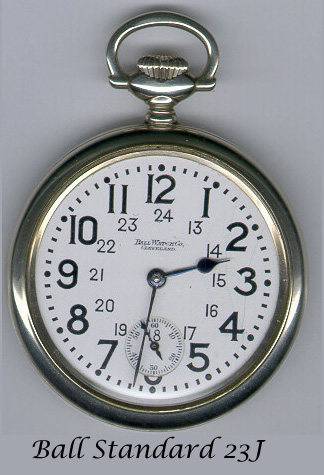 These were the base standards for a railroad-grade watch, however, some railroads were more stringent in their requirements. Most railroads eventually had their own Timekeepers Office, which was responsible for servicing, inspecting, and in some cases was the only approved source for watches approved for use on that specific railroad.
These were the base standards for a railroad-grade watch, however, some railroads were more stringent in their requirements. Most railroads eventually had their own Timekeepers Office, which was responsible for servicing, inspecting, and in some cases was the only approved source for watches approved for use on that specific railroad.Perhaps the feature that most recognizably defines a railroad watch is the lever setting. This was required in order that a train crew member could not accidentally alter the time setting while winding their watch. All employees concerned with the operation of trains must have watches, and new men joining the Company in such capacity must purchase or be issued watches. The list would include assistant superintendents, chief and train dispatchers, yardmasters, trainmasters and their assistants, stationmasters, conductors, brakemen and baggagemen, switch foremen, traveling engineers, engineers and firemen, roundhouse foremen and hostlers as well as division engineers and their assistants, section, bridge and building foremen, track, signal and bridge supervisors, and signal and telephone maintainers.
Why were accurate watches so important to operating a railroad? The common method of operation in the early years was to run trains on a time-interval system; i.e., a train was required to leave a station a certain number of minutes behind an earlier train moving in the same direction. Operation of single-track routes on the basis of a timetable alone, which was common in the early years, had the disadvantage that, if one train were delayed, others also would be delayed, since it was impossible to change the meeting points. In order to make this work, reliable and accurate watches were needed. the CPR was a champion of accurate timekeeping. In fact, it was Sir Sanford Fleming, the CPR Chief Engineer
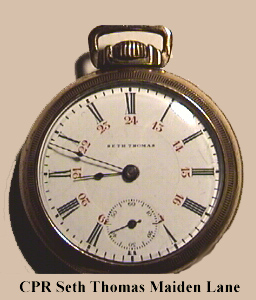 and the man who surveyed the route through the Rocky Mountains, invented the concept of Standard Time. Later on, this system was refined into the timetable and train order method of dispatching. This is a rather complicated method of train operations and involves a lot of paperwork, and a set of complex rules that govern train movements, based on "class" or the priority of one type of train as opposed to others it might encounter. Again, accurate watches were a must.
and the man who surveyed the route through the Rocky Mountains, invented the concept of Standard Time. Later on, this system was refined into the timetable and train order method of dispatching. This is a rather complicated method of train operations and involves a lot of paperwork, and a set of complex rules that govern train movements, based on "class" or the priority of one type of train as opposed to others it might encounter. Again, accurate watches were a must.The first watch developed specifically for the railroad trade was the Elgin "B.W. Raymond", which in the 1867 model was 15 jewel, and key wound. This was soon to change, and by the lat 1880's most, if not all, railroad-approved watches were stem-winders. The adoption of the new standards in 1893 meant that a lot of watches then in use by railroads were no longer acceptable, and the search for suitable replacements was on. Thus, in 1892, the Hamilton Watch Company was formed, with the specific intent of manufacturing high-grade railroad watches, the first one of which was produced in 1893. Not to be outdone, Elgin and Waltham introduced their own models for the railroad trade, Elgin producing the "Father Time" and "Veritas" models, and Waltham the "1883" and "1892" models. Another manufacturer, the Ball Watch Company, did not manufacture movements, but ordered watches built to its specifications from the other companies.
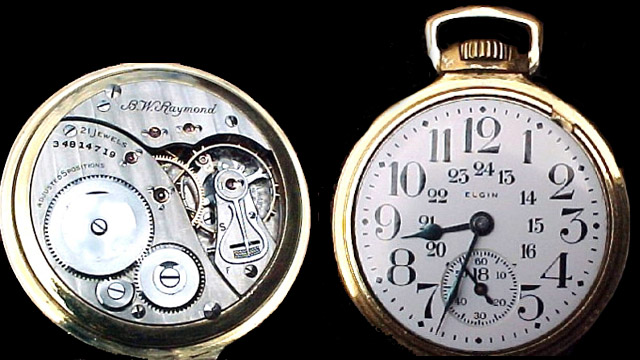
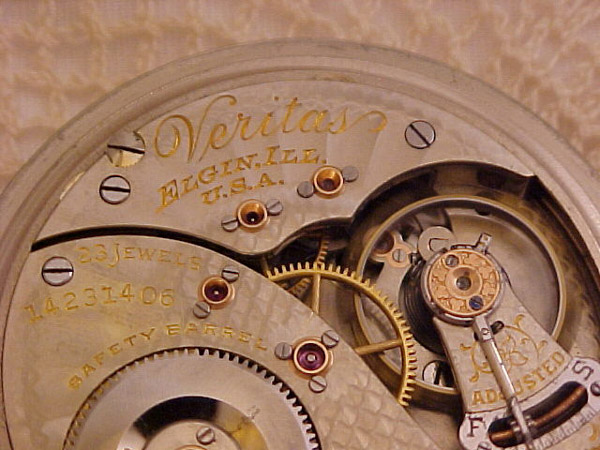
It was during this time, that a uniquely Canadian variant of the railroad watch began to appear, and it is here that we begin our look at the watches and history of the Canadian Pacific Railway.
In 1881, the Canadian Pacific Railway finally began building the transcontinental railway. The CPR received $25 million and 25 million acres of land in exchange for building the railway across Canada. By 1883, the CPR had adopted 24 hour time as a standard, and it was required that all watches used in company service be equipped with the now familiar 24 hour dial. Indeed, this dial has become accepted as the "Canadian" or "Canadian Railroad" dial.
Even more unique were the Waltham watches commissioned by the CPR directly. These were mostly models 1883, and 1892, although some model 1908s were included. These movements were unique in that engraved on them was the CPR logo of a beaver and shield. Waltham serial number lists indicate that between 1897 and 1919 4570 of these "CPR Walthams" were produced for the railway. Another variant commissioned by CP from Waltham was the Canadian Railway Time Service" watch, again, mostly 1883 and 1892 models. These watches had the words "Canadian Railway Time Service" engraved on the back plates. It should be noted that the Waltham factory serial numbers are not entirely accurate, as there exist examples of both CPR and CRTS Walthams that exist outside the given serial number ranges. Nevertheless, only about 6000 of these unique CPR watches were ever made.
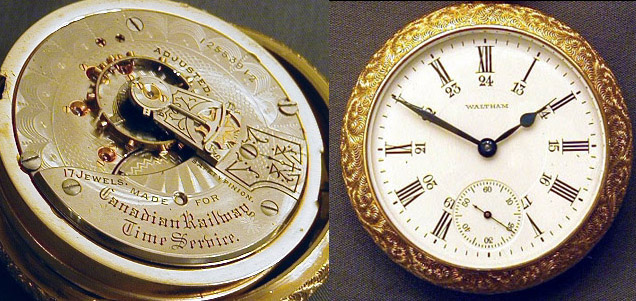
An 1883 Waltham "Canadian Railway Time Service" pocket watch as used on the CPR
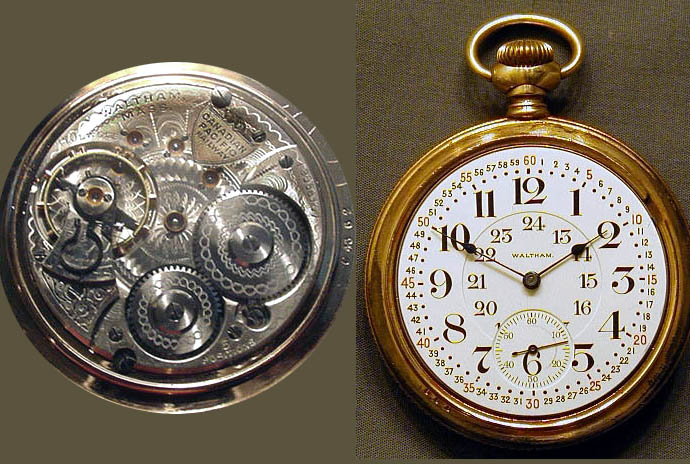
1892 Waltham "Canadian Pacific Railway " pocket watch as used on the CPR
CPR Waltham pocket watches - Serial numbers and model information
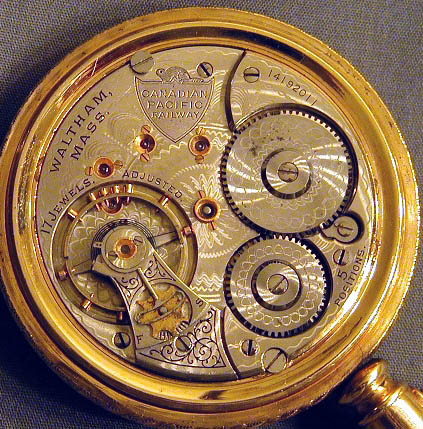
In the 1900's, a watch like the above could cost $30.00 or more, a considerable sum in those days. The CPR Timekeepers Office in Montreal routinely issued watches for company use, but an employee could purchase one through a payroll deduction of one dollar per paycheck.
In day to day use, an employee was required to compare his watch to the standard clock upon reporting for work and note the deviation on a timing card. Every two weeks he (and very occasionally - except during WWII - she) was required to bring the card to a company watch inspector and have it verified and be issued a new card. Employees were not allowed to reset the time on their watches, and therefore the inspector would be able to calculate the accuracy and deviation from standard of the watch. The inspector would reset the watch if it was within specification and re-issue a timing card to the employee. If the watch needed adjusting or regulating, the watch inspector would issue a loaner watch to be used during the time the employees watch was being serviced. Occasionally, some high-seniority passenger engineers and conductors would purchase a second duty watch simply to avoid having to use a loaner, which was viewed as being somewhat distasteful.
Again, like most railroads, the CPR had a list of approved watches that went beyond one manufacturer, so one should not think that these CPR Walthams were the only watch in use at that time. In 1899, the approved watch list looked like this:
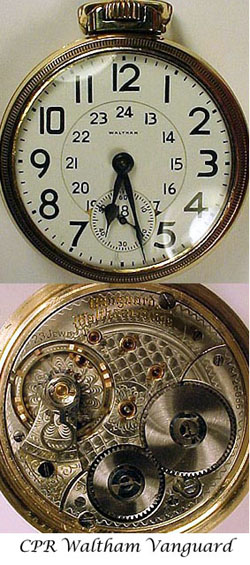 By 1900, the railroad watch had evolved to the point that for the next sixty years, no fundamental design changes or modifications were made. There were improvements made, however, most notably in the use of materials such as Hamilton's Elinvar for the hairspring. By 1920, 18s watches were falling out of favour, and in 1928, the CPR dropped all 18s pocket watches from the approved list. In doing so, most of the old CRTS and CPR Walthams were retired. Most ended up back up in the Chief Timekeepers Office in Montreal, but those employees who had purchased their watch, rather than having had it issued to them, ended up keeping them. A lot of watches no longer suitable for operational duty ended up being given to company officials and managers who would wanted a CPR watch, but would probably never be involved in the actual running of trains.
By 1900, the railroad watch had evolved to the point that for the next sixty years, no fundamental design changes or modifications were made. There were improvements made, however, most notably in the use of materials such as Hamilton's Elinvar for the hairspring. By 1920, 18s watches were falling out of favour, and in 1928, the CPR dropped all 18s pocket watches from the approved list. In doing so, most of the old CRTS and CPR Walthams were retired. Most ended up back up in the Chief Timekeepers Office in Montreal, but those employees who had purchased their watch, rather than having had it issued to them, ended up keeping them. A lot of watches no longer suitable for operational duty ended up being given to company officials and managers who would wanted a CPR watch, but would probably never be involved in the actual running of trains. 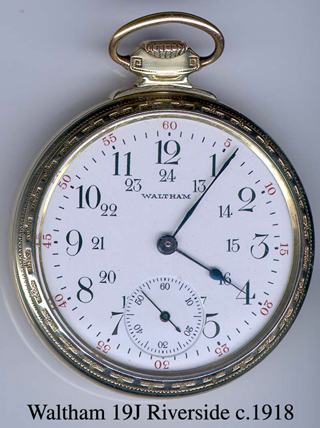 These watches were quite often recased. Working watches were usually in steel or gold filled cases, and a large number had acrylic crystals. Acrylic was usually preferred by crews for its break- resistance. Locomotive cabs, were cramped, dirty places, with plenty of hard corners to chip or shatter a watch crystal that was accidentally bumped against them. Quite a few of these "recycled" watches ended up in 14K gold cases, with the odd one being recased in a hunter case. While these watches were, in most cases, still quite capable of meeting railroad specifications, they were quite the common sight around company headquarters and division points as they could be had at a very reasonable price.
These watches were quite often recased. Working watches were usually in steel or gold filled cases, and a large number had acrylic crystals. Acrylic was usually preferred by crews for its break- resistance. Locomotive cabs, were cramped, dirty places, with plenty of hard corners to chip or shatter a watch crystal that was accidentally bumped against them. Quite a few of these "recycled" watches ended up in 14K gold cases, with the odd one being recased in a hunter case. While these watches were, in most cases, still quite capable of meeting railroad specifications, they were quite the common sight around company headquarters and division points as they could be had at a very reasonable price.1957 CPR Approved Pocket Watch List
Another interesting difference between the CPR and most of the US railroads is that the CPR had quite a few Swiss made pocket watches on the approved watch list. Most notable are the Longines and Brandt (which were actually Omega's) models. The Zenith Extra RR 56 was the last pocket watch to be approved for the last or 1957 approved list.
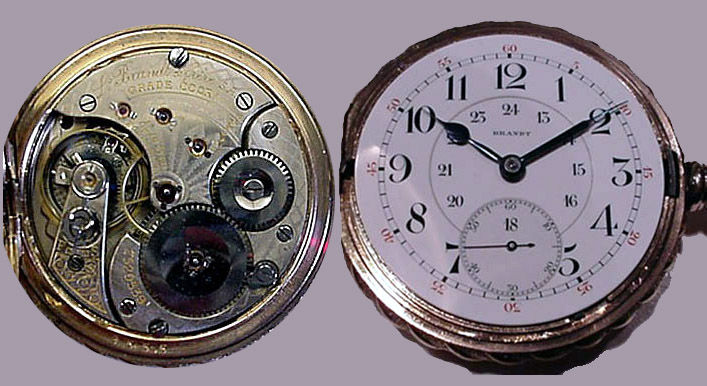
These Swiss CPR watches have become quite rare, and are quite collectable. The Zenith Extra RR 56 has quite and interesting story behind it. In 1956, CPR wished to have an alternate supplier of a "modern" RR watch. At the time, the favoured models were the Waltham Vanguard, and the Hamilton 992B. New Walthams were becoming harder to acquire as Waltham was in its last days, and it was feared that if there was any similar problem with Hamilton, a source of new watches would be difficult to obtain. At that time, Peter Kushnir, who was the Chief Timekeeper contacted Zenith and asked for a RR watch. Zenith responded with the Extra RR 56, which featured 21 jewels, antimagnetic balance, micrometric regulator and was adjusted to six positions, temperature and isochronism for a total of 9 adjustments. I have in my collection, Zenith Extra RR 56 # 4732453. According to correspondence I have had with Zenith, this watch is one of a total production run of 1700. The most interesting thing about the Zenith is that the current 5011K pocket watch movement is almost identical to the one used in the RR 56. My example is in almost mint condition, and has no indications of ever having been used, or serviced. I do know some of the history of this watch, and it appears that it was purchased from the Chief Timekeepers Office in Montreal, as a replacement for a Waltham Vanguard that was the current service watch in use by a Mr. Stone, who was an engineer out on the Montreal-Toronto passenger run. He subsequently retired before ever using the Zenith, and it was given to his son after his death. I acquired it in 1999, when his son decided he didn't need two pocket watches, and considered the Vanguard to be his father's "real" railroad watch. He knew of my passion for watches and railroad history, and figured the Zenith would have a good home. Also in my collection is a 1918 CPR Waltham Riverside, that was acquired by my grandfather after it was returned to the Timekeepers office after no longer being on the approved list. That watch, even though it was made in 1918, still keeps time to within 45 seconds per week. The Zenith runs considerably better, keeping time to within 15 seconds per week.

Another interesting variation that one often sees on CPR watches is the "dual Time Zone" setup. In certain parts of the country, a rail subdivision may span two time zones, (example, a crew starting out in the Laggan Subdivision in the Rockies would start out on Central Time, but once they crossed over into the Mountain Subdivision, they would be governed by Pacific Time.) and as crews were not supposed to adjust their watches, one easy solution was to add a second hour hand, offfset by exactly one hour. These hands were usually colored a matte red, but one occasionally sees a second hour hand that was gold coloured. These dual time zone watches were not common, but they were a elegant solution where needed.
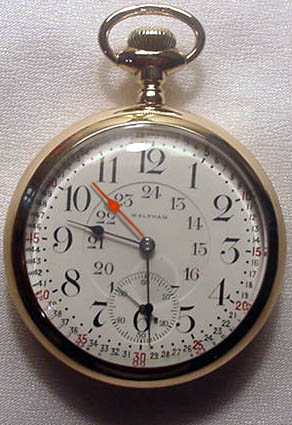 Dual Time Zone Waltham Vanguard |
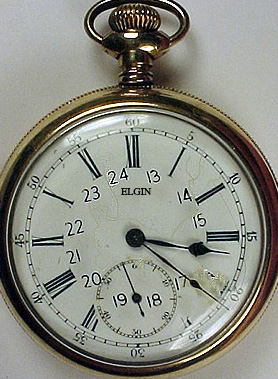 24 Hour Crystal Elgin |
Every once in a while, there would arise the situation where an employee would already have a watch that would qualify as an approved railroad watch, except for the 24 hour dial. This was common with watches that were purchased from private jeweler. The solution: Put the 24 hour chapter numerals on the inside of an acrylic crystal. This modification was very cost effective, and as acrylic crystals were often the norm, relatively easy to do and maintain. The biggest problem with using these crystals, occurred when the bezel or case threads wore a bit, or became dirty. When either of these things occurred, it was fairly easy for the 24 hour chapter to get out of line with the dial numbering, as can be seen in the example above. CPR watches with these crystals have become quite rare, and I personally have only ever seen one. The watch in question was originally purchased in the United States and was converted for CPR use by the replacement of the original crystal with one of the 24 hour marked ones. This watch, until recently was in the private collection of a long-time CPR employee in Montreal.
By the 1960's however, railroad pocket watches were falling out of favor and wristwatches began to appear in rails service more regularly. The list of approved wristwatches grew, and the number of pocket watches approved remained unchanged. The 1957 list of approved watches was the last one to include pocket watches. Curiously enough, any pocket watch that was on the 1957 list is still considered an approved watch for railroad service today by the Canadian Pacific Railway. Towards the end of their use, the most popluar pocket watches in use by CPR rail crews tended to be the Hamilton 992B, and the Waltham Vanguard.
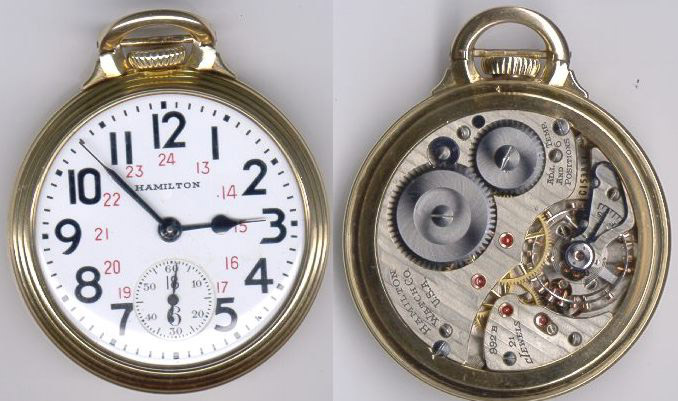
Today, rail operations are pretty much computerized. Indeed, one only need look at a typical Rail Network Management Centre to see exactly how much things have changed from the old track occupancy and timetable operation days. As you can see from the pictures below, all aspects of rail operations can be monitored and managed from this hi-tech facility. Dispatchers no longer use telegraph , but instead computer screens and two-way radio. GPS systems will soon be used to track train movements to the meter.
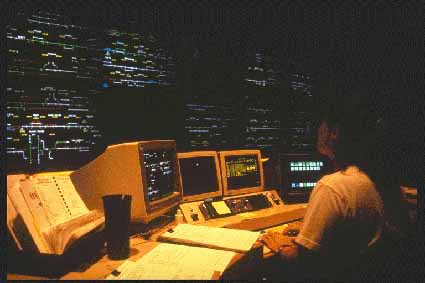
Interestlingly enough, the Operating Rules still call for accurate and approved watches to be carried by operating crews or anyone who works with operating crews. The standards have changed a bit since the original ones, stating that:
"Every conductor, locomotive engineer, trainman, pilot, foreman, snow plow foreman and such other employees as the company may direct, shall, when on duty, use a railway approved watch and shall;
- Be responsible to ensure that it is kept in proper working condition so that it does not reflect a variation of more than thirty seconds in a twenty-four hour period;
- set it to reflect the correct time if it reflects a variation of more than thirty seconds;
- not regulate its movement.
"In the application of Rule 2, a railway-approved watch is a reliable watch that simultaneously displays hours, minutes, and seconds in the twenty-four hour system. Every employee in possession of a valid certificate of rules qualification shall, when in service connected with the movement of trains or engines, use a reliable railway-approved watch or clock."The railroad industry has changed dramatically since its early days, but it has always maintained the requirement for accurate and reliable watches. The safe operation of a railroad is still dependant on having trains be exactly where they should be, when they should be and an accurate watch is still one of the best ways to do this. Today you are more likely to see quartz wristwatches than the classic pocket watch, but there are some still in use.Its ironic to note that almost any of the old watches, even from the 1889 list, can, if they have been properly maintained, beat the current standard by a factor of seven.
One of the more pleasurable duties I have had lately is in helping locate examples of CP approved pocket watches that are in good running order. CP is currently in the process of restoring to running condition 2816, a 1950's 4-6-4 Hudson steam locomotive. She will be used for special events, excursions, and as a visible symbol for Canadian Pacific Railway. The crews will be dressed in period attire, which includes pocket watches. In a way its a fitting tribute to the railroad pocket watch that they are being actively sought out to be pressed back into service on such a glorious endeavor.
I hope you have found this article to be informative and enjoyable. I'd like to express thanks to the following people, who were valuable sources of information: Larry Jones, for his scans of 1883/1892 CPR/CRTS movements. All my friends in Corporate Archives, who put up with my requests for information on serial number lists and standards. John Stone. for allowing me the privilege of acquiring that 1956 Zenith, and to all those at CP who took time to allow me to see and in some cases, photograph or scan, their prized pocket watch possessions, and family heirlooms.
If there are any comments or questions, I can be reached by email at: hac@home.com.
Cheers,
Harold Clitheroe
